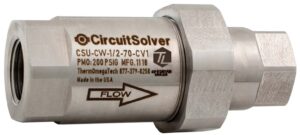In the News: Legionella & the Cold Water Problem in Plumbing Engineer
Prepare Your Cold-Water Circulation System and Battle Against Legionella
The COVID-19 pandemic has brought attention to vulnerabilities in plumbing systems, including cold-water systems. Stagnation and warming of unbalanced cold-water systems during building closures have raised concerns about Legionella growth.
When cold water flow is minimal or stopped altogether, as seen during the recent lockdowns that left buildings unoccupied for long periods, disinfectant levels evaporate, and temperatures gradually rise to Legionella’s growth range (77–113°F, 25–42°C), leading to bacteria colonization and uneven free chlorine distribution throughout the system.
Legionella causes a pneumonia-type illness called Legionnaires’ disease and a mild flu-like illness called Pontiac fever. Legionella bacteria can grow and thrive in plumbing systems. When water containing Legionella is used for showers or water fountains, people can inhale or ingest and aspirate tiny droplets of contaminated water, which can lead to infection if the bacteria are present in a dangerous amount.
While much attention has been given to mitigating Legionella in hot water systems, there is a need for proactive measures in cold water systems. “There has been a heightened awareness in the industry focusing on Legionella Mitigation, particularly in domestic water systems,” explains Tom Ruggierio, Director of Sales, Commercial Plumbing, ThermOmegaTech.
The Veterans Health Administration (VHA) has taken a proactive approach in addressing Legionella mitigation in cold water plumbing systems at their Department of Veterans Affairs (VA) medical facilities by planning for “periods of low flow or non-use.”
The VHA 1061(1) directive states, “The use of piping system insulation, automatic drain devices, and recirculation to limit the rate and duration of an increase in cold water temperature in combination with appropriate biocide levels can effectively prevent Legionella growth.”
The Solution: Cold-Water Recirculation
Recirculating cold water eliminates stagnation, which promotes harmful bacteria growth, and provides consistent distribution of residual chlorine throughout the domestic cold-water system.
- Keeps water moving
- Maintains water quality to reduce stagnation
- Ensures residual chlorine is distributed throughout the cold water system
- Keeps water temperature in branches and risers evenly distributed, minimizing heat gain
- VHA Directive
Balancing Cold Water Systems
“The CircuitSolver® was designed to balance domestic cold-water systems (DCWS) and reduce the risk of bacterial growth,” Ruggierio explains. “Our engineers developed a valve that can dynamically react to the ever-changing conditions that systems may experience. This includes changes in building occupancy, expansion, reduced utilization, and other variables affecting system balance.”
The CSU-CW valve utilizes the same reliable and precise thermal actuator technology as the original CircuitSolver®. It addresses critical issues related to Legionella mitigation in cold water recirculation systems by maintaining a stable temperature. It accomplishes this by continuously monitoring the water temperature and modulating flow to maintain a set temperature at the end of each branch or riser.
The valve operates over a 10°F temperature range. For example, a valve specified for a desired return temperature of 60°F will open at 70°F (10°F above the desired return temperature). At 60°F, the valve is in its closed position. A bypass in the design always allows water to flow back to the pump so that the pump is never dead-headed.
The Use of Thermostatic Technology
ThermOmegaTech® is a world leader in designing and manufacturing self-actuating thermostatic valve technology. They recently turned their attention to battling the Legionella risk in cold water systems.
“The Cold-Water Balancing Valve (CSU-CW) from CircuitSolver® is the market’s first cold water thermostatic balancing valve,” Ruggierio says. “Manual balancing valves could be used, but they are not dynamic and won’t respond to the changing conditions experienced in both hot and cold domestic water systems.”
“CircuitSolver® technology was already an innovative balancing method for domestic hot water recirculation systems, and now there is a solution for cold water systems, too. It’s another step in the right direction to improve plumbing system designs,” Ruggierio says.
“To date, we have provided thermostatic cold water balancing for three VA facilities, with interest from a few others. The more we investigated it, the more we recognized the importance of recirculating cold water. This technology helps to mitigate not only Legionella but also other bacteria and water-borne pathogens from growing. Implementing a cold-water recirculation system is not a nominal task, but what price can one put on a person’s health and safety?” Ruggierio explains. “We are in the early stages of this process. I see interest in this growing over the next several years, expanding from the VA into other healthcare facilities and the hospitality industry.
To achieve stability, system balancing must continually address the ongoing changes occurring within a building. Thermostatic balancing valves adjust dynamically, providing the best opportunity for sustainability and Legionella mitigation.
Read the full feature in Plumbing Engineer here
The feature originally ran in December 2023.


